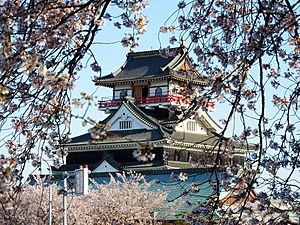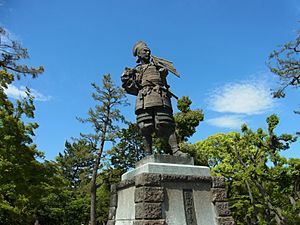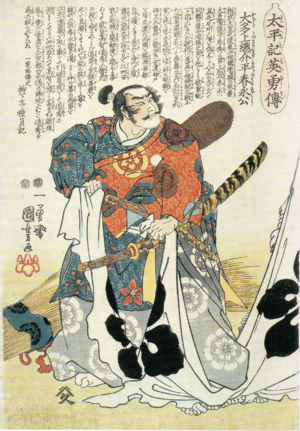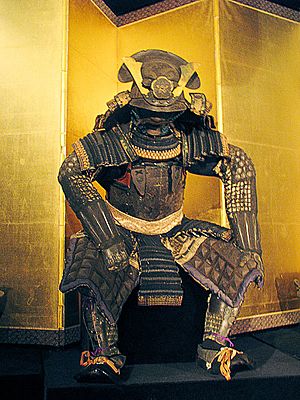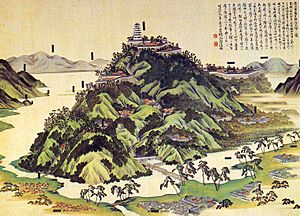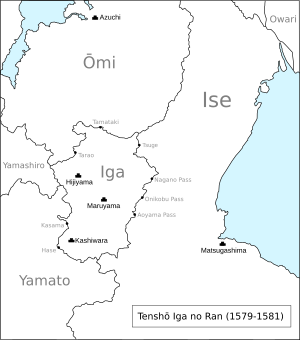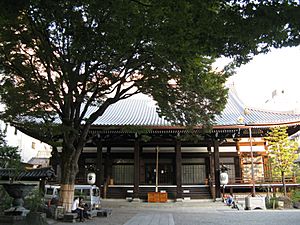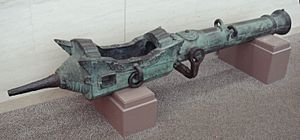Oda Nobunaga facts for kids
Quick facts for kids
Oda Nobunaga
|
|
|---|---|
| 織田信長 | |
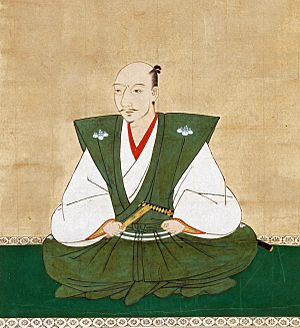
Oda Nobunaga in a 16th-century portrait by Kanō Motohide (detail)
|
|
| Chancellor of the Realm (Daijō-daijin) |
|
| In office 1578–1582 |
|
| Monarch | Ōgimachi |
| Preceded by | Nijō Haruyoshi |
| Succeeded by | Konoe Sakihisa |
| Head of Oda clan | |
| In office 1551–1582 |
|
| Preceded by | Oda Nobuhide |
| Succeeded by | Oda Hidenobu |
| Personal details | |
| Born |
Kippōshi
23 June 1534 Nagoya, Owari, Japan |
| Died | 21 June 1582 (aged 47) Honnō-ji, Kyoto, Japan |
| Spouse | Nōhime |
| Domestic partner | Kitsuno (concubine) |
| Children |
|
| Parents |
|
| Relatives | Lady Otsuya (aunt) Saitō Dōsan (father-in-law) Oichi (sister) Azai Nagamasa (brother-in-law) Shibata Katsuie (brother-in-law) Oda Nobuhiro (brother) Oda Nobuyuki (brother) Oda Nobukane (brother) Oda Nagamasu (brother) Oda Nobuharu (brother) Oda Nobutoki (brother) Oda Hidetaka (brother) Chacha (niece) Ohatsu (niece) Oeyo (niece) Ashikaga Yoshiaki (adopted son) |
| Signature |  |
| Nicknames | "Fool of Owari" "Demon King" |
| Military service | |
| Allegiance | |
| Rank | Daimyō, Dainagon, Udaijin, Daijō-daijin |
| Unit | |
| Commands | Azuchi Castle |
| Battles/wars | Battle of Akatsuka Battle of Muraki Battle of Kiyosu Battle of Inō Battle of Ukino Battle of Okehazama Mino Campaign Ise Campaign Omi Campaign Siege of Kanegasaki Battle of Anegawa Siege of Mount Hiei Siege of Ichijodani Siege of Odani Siege of Nagashima Battle of Nagashino Battle of Tedorigawa Ishiyama Hongan-ji War Tenshō Iga War Honnō-ji Incident see below |
Oda Nobunaga (織田 信長; 23 June 1534 – 21 June 1582) was a powerful Japanese lord, known as a daimyō. He was one of the most important leaders during the Sengoku period, a time of civil war in Japan. Many people see him as the first "Great Unifier" of Japan.
Nobunaga led the strong Oda clan. In the 1560s, he started a war against other lords to bring all of Japan under one rule. He became the most powerful daimyō, even removing the shogun Ashikaga Yoshiaki from power in 1573. By 1580, he had conquered most of Honshu island. He also defeated the Ikkō-ikki rebels. Nobunaga was known for his new military ideas, promoting free trade, and making changes to Japan's government. He also started the Momoyama art period. However, he was also known for his harsh actions against those who did not agree with him.
In 1582, Nobunaga was killed in the Honnō-ji Incident. His loyal general, Akechi Mitsuhide, attacked him in Kyoto and forced him to take his own life. After Nobunaga's death, his followers Toyotomi Hideyoshi and Tokugawa Ieyasu continued his work. They finished uniting Japan soon after. Nobunaga is remembered as one of the three great unifiers of Japan, along with Hideyoshi and Ieyasu.
Contents
- Early Life: Growing Up in Owari
- Unifying Owari Province: Early Challenges
- Rise to Power: Expanding Influence
- Unifying Japan: Nobunaga's Conquests
- Death: The Honnō-ji Incident
- Historical Importance: Unifying Japan
- Nobunaga's Impact: Military and Policies
- Nobunaga's Family
- Images for kids
- See also
Early Life: Growing Up in Owari
Oda Nobunaga was born on June 23, 1534, in Nagoya, Owari Province. He was the second son of Oda Nobuhide, the leader of the powerful Oda clan. His mother was Tsuchida Gozen. Nobunaga was given the childhood name Kippōshi.
As a child and teenager, he was known for his unusual behavior. People called him Owari no Ōutsuke, which means "The Fool of Owari." Nobunaga spoke clearly and had a strong presence. He often ran around with other young people, not caring about his high social rank. When firearms came to Japan, he became very fond of tanegashima guns.
In 1549, Nobuhide made peace with Saitō Dōsan. He arranged for Nobunaga to marry Dōsan's daughter, Nōhime. This made Dōsan Nobunaga's father-in-law.
Unifying Owari Province: Early Challenges
Taking Over the Oda Clan
In 1551, Oda Nobuhide died suddenly. It is said that Nobunaga acted strangely at the funeral. He threw ceremonial incense at the altar. Even though Nobunaga was his father's rightful heir, some members of the Oda clan were against him.
Nobunaga gathered about 1,000 men. He defeated the family members and their allies who opposed him. However, Imagawa Yoshimoto sent an army. This army attacked Anjō castle, where Nobunaga's older brother, Oda Nobuhiro, lived. Nobuhiro was trapped. Nobunaga saved him by giving up a hostage, nine-year-old Matsudaira Takechiyo. This boy later became known as Tokugawa Ieyasu. Later, Nobuhiro tried to plot against Nobunaga. But Nobunaga forgave him when the plot failed.
In early 1552, some of Oda's top followers switched to the Imagawa clan. Nobunaga attacked them but was pushed back. He lost some land in eastern Owari to the Imagawa.
Securing Leadership in Owari
In 1552, Nobuhide's younger brother, Oda Nobutomo, attacked Nobunaga's land. Nobunaga fought him off and burned parts of Kiyosu Castle.
In 1553, Hirate Masahide, a trusted mentor to Nobunaga, took his own life. He did this to make Nobunaga take his duties more seriously. Meanwhile, Shiba Yoshimune told Nobunaga about a plan to kill him. Later, Oda Nobutomo had Yoshimune killed. Nobunaga then surrounded Kiyosu Castle, waiting for a chance to attack.
In 1554, Nobunaga defeated the powerful Imagawa clan. Their army had entered eastern Owari Province. After winning back eastern Owari, Nobunaga turned to Kiyosu Castle. He defeated and captured his uncle, Oda Nobutomo, and had him killed.
In 1556, Nobunaga sent an army to help his father-in-law, Saitō Dōsan. Dōsan's son, Saitō Yoshitatsu, had turned against him. This effort failed, as Dōsan was killed. Yoshitatsu became the new ruler of Mino. Later, Nobunaga defeated his younger brother, Oda Nobuyuki, who was his main rival. Nobuyuki survived but planned another rebellion.
Nobuyuki started his second rebellion in 1557. But he was defeated, and his castle was destroyed. In 1558, Nobunaga helped protect a lord who had joined his side. This lord had left Imagawa Yoshimoto, a very powerful daimyō. Nobuyuki tried to plot again. But one of his followers told Nobunaga, and Nobuyuki was killed on November 2, 1558.
By 1559, Nobunaga had taken and destroyed Iwakura Castle. He had removed all opposition within the Oda clan. He now ruled Owari Province without challenge.
Rise to Power: Expanding Influence
Facing the Imagawa Clan
Imagawa Yoshimoto had been an enemy of Nobunaga's father for a long time. He wanted to expand his land into Owari Province. In 1560, Yoshimoto gathered a large army of 25,000 men. He marched towards Kyoto, saying he wanted to help the weak Ashikaga shogunate. The Matsudaira clan also joined Yoshimoto's forces.
The Imagawa army quickly took over border forts. Forces led by Matsudaira Motoyasu captured Marune Fortress. Against this, the Oda clan had only 2,000 to 3,000 men. Some advisors told Nobunaga to hide in Kiyosu Castle and wait. But Nobunaga refused. He said only a strong attack could make up for the enemy's larger numbers. He calmly ordered a counterattack.
Battle of Okehazama: A Surprise Victory
In June 1560, Nobunaga's scouts reported that Yoshimoto was resting in a narrow gorge. This spot was perfect for a surprise attack. The Imagawa army was celebrating their victories. While Yoshimoto thought victory was certain, Nobunaga's forces marched to the Atsuta Shrine. This was a fortified temple near the Imagawa camp.
Nobunaga then moved to Zensho-ji fort. He set up a fake army there. He quickly marched behind Yoshimoto's camp and attacked after a big thunderstorm. Yoshimoto was killed by two Oda samurai. With this victory, Oda Nobunaga gained much respect. Many samurai and warlords promised to be loyal to him. This battle was also when Nobunaga first noticed the talents of Kinoshita Tōkichirō. This man would later become Toyotomi Hideyoshi.
New Alliances: Matsudaira and Takeda
After this battle, the Imagawa clan became much weaker. They no longer controlled the Matsudaira clan. In 1561, Oda Nobunaga formed an alliance with Matsudaira Motoyasu (who became Tokugawa Ieyasu). This was important, even though the two clans had been enemies for decades. Nobunaga also made an alliance with Takeda Shingen. He did this by arranging for his daughter to marry Shingen's son.
The Mino Campaign: Expanding Territory
In 1561, Saitō Yoshitatsu, an enemy of the Oda clan, died suddenly. His son, Saitō Tatsuoki, took over. But Tatsuoki was young and not as good a leader or military planner as his father. Nobunaga took advantage of this. He moved his base to Komaki Castle and began his campaign in Mino Province. He defeated Tatsuoki in two battles in June of that year.
Nobunaga convinced Saitō's followers to leave their weak master. This greatly weakened the Saitō clan. In 1564, Oda Nobunaga sent his follower, Kinoshita Tōkichirō, to convince many warlords in Mino to support the Oda clan. In 1566, Nobunaga told Kinoshita to build Sunomata Castle. This castle was built on the Sai River, across from Saitō land. It was meant to be a base for Oda forces and to surprise the enemy.
In 1567, three samurai generals serving the Saitō clan decided to switch sides. They joined Oda Nobunaga's forces. Their combined armies launched a final, successful attack at the Siege of Inabayama Castle. After taking the castle, Nobunaga changed its name and the surrounding town to Gifu. Nobunaga got the name Gifu from a legendary mountain in China. He showed his ambition to conquer all of Japan. He also started using a new personal seal that said Tenka Fubu. This means "All under heaven, spreading military force." Remains of Nobunaga's home in Gifu can still be seen today in Gifu Park.
Marching to Kyoto: The Capital Campaign
After conquering Mino Province in 1567, Nobunaga sent Takigawa Kazumasu to attack Ise Province. This campaign defeated many families in Ise. Also, to strengthen his alliance with Azai Nagamasa from Omi Province, Nobunaga arranged for his sister, Oichi, to marry Nagamasa. Nobunaga wanted peace with the Azai clan because their land was important. It was located between the Oda clan's land and the capital, Kyoto.
In 1568, Ashikaga Yoshiaki and his bodyguard, Akechi Mitsuhide, came to Gifu. They asked Nobunaga to lead a campaign to Kyoto. Yoshiaki's brother, the 13th shogun, had been killed. Yoshiaki wanted revenge. Nobunaga agreed to make Yoshiaki the new shogun. He saw this as a chance to enter Kyoto.
An obstacle in southern Ōmi Province was the Rokkaku clan. They refused to recognize Yoshiaki as shogun. Nobunaga quickly attacked Chōkō-ji Castle, driving the Rokkaku clan out. Other Oda forces defeated the Rokkaku in battle. They entered Kannonji Castle before Nobunaga continued his march to Kyoto. Later, the Rokkaku tried to take back the castle but were pushed back. The approaching Oda army made the Matsunaga clan join the future shogun.
On November 9, 1568, Nobunaga entered Kyoto. He drove out the Miyoshi clan, who had supported the previous shogun. Nobunaga then made Yoshiaki the 15th shogun. However, Nobunaga refused any official titles from Yoshiaki. He had great respect for the Emperor Ōgimachi.
Unifying Japan: Nobunaga's Conquests
Conflicts with Asakura, Ashikaga, and Azai
After making Yoshiaki shogun, Nobunaga asked all local lords to come to Kyoto. Asakura Yoshikage, a powerful lord, refused. Nobunaga said this was disloyal to both the shogun and the emperor. Using this as an excuse, Nobunaga raised an army and marched into Echizen Province. In early 1570, Nobunaga attacked the Asakura clan's land and besieged Kanagasaki Castle.
This action caused problems between Nobunaga and shogun Ashikaga Yoshiaki. Their relationship became difficult. Yoshiaki secretly started an "anti-Nobunaga alliance." He plotted with other lords to get rid of Nobunaga. Azai Nagamasa, Nobunaga's brother-in-law, broke his alliance with the Oda clan. He chose to honor the long-standing Azai-Asakura alliance. With help from the Rokkaku clan, Miyoshi clan, and the Ikkō-ikki, the anti-Nobunaga alliance became very strong. This caused many problems for the Oda clan. Nobunaga found himself fighting both the Asakura and Azai forces. When defeat seemed certain, Nobunaga decided to retreat from Kanagasaki, which he did successfully.
Battle of Anegawa: A Major Victory
In July 1570, the Oda and Tokugawa allies attacked Yokoyama Castle and Odani Castle. Later, the combined Azai and Asakura forces came to fight Nobunaga. Nobunaga moved to the south bank of the Anegawa River. The next morning, on July 30, 1570, the battle began.
Tokugawa Ieyasu joined his forces with Nobunaga. The Oda and Azai fought on the right side. The Tokugawa and Asakura fought on the left. The battle became a fierce fight in the shallow Anegawa River. For a while, Nobunaga's forces fought the Azai upstream. The Tokugawa warriors fought the Asakura downstream. After the Tokugawa forces defeated the Asakura, they turned and attacked the Azai from the side. Troops who had been waiting then attacked the Azai from the other side. Soon, both the Oda and Tokugawa forces defeated the combined Azai and Asakura clans.
In 1573, Nobunaga led 30,000 troops. He attacked Ichijōdani Castle and Odani Castle. Nobunaga successfully destroyed the Azai and Asakura clans. Their leaders died.
Campaigns Against the Ikkō-ikki
Nobunaga faced a big threat from the Ikkō-ikki. This was a group of people who followed the Jōdo Shinshū Buddhist sect. They started as a self-defense group. But many people disliked the samurai because of the constant fighting. So, the Ikkō-ikki grew in numbers. By the time Nobunaga rose to power, they were a large armed force against samurai rule.
In August 1570, Nobunaga started the Ishiyama Hongan-ji War against the Ikkō-ikki. He was also fighting his samurai rivals at the same time. In May 1571, Nobunaga attacked Nagashima. This was a series of Ikkō-ikki forts in Owari Province. This began the Sieges of Nagashima. However, Nobunaga's first attack on Nagashima failed. His trusted general was badly hurt, and many samurai were lost. Despite this, Nobunaga was inspired to attack again.
The Siege of Mount Hiei
The Enryaku-ji temple on Mount Hiei was a problem for Nobunaga. The temple's warrior monks were helping his enemies. The temple was also close to his power base. In September 1571, Nobunaga attacked the Enryaku-ji temple. He then surrounded Mount Hiei and burned it down. Nobunaga's forces destroyed and burned all buildings. They killed monks, regular people, women, and children. They eliminated anyone who had escaped their first attack. This action earned him the name "Demon daimyō" or "Devil King."
The Sieges of Nagashima
After his success at Mount Hiei, Nobunaga attacked Nagashima a second time in July 1573. He personally led a large force with many arquebusiers (gunners). However, a rainstorm made his guns useless. The Ikkō-ikki's own gunners could fire from covered spots. Nobunaga himself was almost killed and had to retreat. This second siege was considered his biggest defeat.
In 1574, Nobunaga launched a third siege of Nagashima. His general Kuki Yoshitaka started a naval blockade. This allowed Nobunaga to capture outer forts and part of the Nagashima complex. The sieges of Nagashima finally ended when Nobunaga's men completely surrounded the area. They set it on fire, killing tens of thousands of defenders. This caused huge losses for the Ikkō-ikki.
Conflict with the Mori Clan
Before his death, Mori Motonari had said he was not a friend to Nobunaga. His successor, the young Terumoto, openly challenged Nobunaga. The Mori clan became involved in the Ishiyama Hongan-ji War. This was Nobunaga's attack on a religious stronghold that began in 1570.
The Siege of Ishiyama Hongan-ji
Nobunaga had been attacking the Ikkō-ikki's main stronghold at Ishiyama Hongan-ji in Osaka. Nobunaga's attack slowly made progress. But the Mōri clan broke his naval blockade. They started sending supplies into the strong fort by sea.
As a result, in 1577, Nobunaga ordered his generals to act. Takigawa Kazumasu was to stop the Ikko-ikki in Kii Province. Hashiba Hideyoshi was to conquer the Chūgoku region from the Mōri clan. Akechi Mitsuhide was to calm Tanba Province. Kuki Yoshitaka was to help with attacks from the sea. Nobunaga eventually blocked the Mori's supply lines.
In 1580, ten years after the siege began, the son of the Chief Abbot surrendered the fort to Nobunaga. Their supplies had run out, and the Emperor had officially asked them to surrender. Nobunaga spared the lives of the defenders. But he forced them out of Osaka and burned the fort to the ground. Even though the Ikkō-ikki made a final stand in Kaga Province, Nobunaga's capture of Ishiyama Hongan-ji greatly weakened them as a military force.
Conflict with the Takeda Clan
One of the strongest rulers in the anti-Nobunaga alliance was Takeda Shingen. He used to be an ally of the Oda clan. In 1572, Shingen ordered one of his generals to attack Iwamura Castle. Nobunaga's aunt, Lady Otsuya, plotted against the Oda clan. She surrendered the castle to the Takeda and married the general. From then on, the Takeda-Oda relationship worsened. Nobunaga started a war against the Takeda clan.
In the same year, Shingen decided to march towards Kyoto. He invaded Tokugawa land. Nobunaga was busy fighting on another front. He sent little help to Tokugawa Ieyasu, who lost the Battle of Mikatagahara in early 1573. However, after the battle, Tokugawa's forces launched night raids. This made Takeda think a counter-attack was coming. This bluff saved the vulnerable Tokugawa. This event was important for Tokugawa's idea of strategic patience. Soon after, the Takeda forces were stopped when Shingen died in April 1573.
Battle of Nagashino: A Turning Point

In 1575, Takeda Katsuyori, Shingen's son, moved into Tokugawa land. He attacked Yoshida castle and then besieged Nagashino Castle. Katsuyori was angry when a lord rejoined the Tokugawa clan. He had planned to take the Tokugawa-controlled Okazaki Castle. But this plan failed. Tokugawa Ieyasu asked Nobunaga for help. Nobunaga personally led an army of about 30,000 men to help Nagashino Castle.
The combined force of 38,000 men under Oda Nobunaga and Tokugawa Ieyasu defeated the Takeda clan. They used arquebuses (early firearms) in a smart way at the important Battle of Nagashino. Nobunaga made up for the gun's slow reloading time. He organized his gunners and archers in three rows, firing one after another. Takeda Katsuyori also wrongly thought that rain had ruined Nobunaga's gunpowder. This battle was the biggest defeat for the Takeda clan.
The Takeda clan finally ended in 1582. Nobunaga's son, Oda Nobutada, and Tokugawa Ieyasu's forces conquered Kai Province. Takeda Katsuyori was defeated and then took his own life.
End of the Ashikaga Shogunate
After Takeda Shingen died in May 1573, Nobunaga's entry into Kyoto was different. He focused on Ashikaga Yoshiaki, who had openly shown hostility. Nobunaga defeated Yoshiaki's forces. The power of the Ashikaga clan was effectively destroyed on August 27, 1573. Nobunaga drove Yoshiaki out of Kyoto and sent him away. Yoshiaki became a Buddhist monk, ending the Ashikaga shogunate.
Imperial Court Appointments
After the Ashikaga shogunate ended, the power of the Imperial Court also started to decline. This changed when Oda Nobunaga entered Kyoto. He showed his loyalty, indicating that the Emperor had the Oda clan's support.
In early 1574, Nobunaga was given a higher rank in the Imperial Court. He was made a Court Advisor. The court continued to give him many official titles almost every year. This was possibly to keep him happy. Nobunaga received titles like Major Counselor, General of the Right of the Imperial Army, and Minister of the Right in 1576. In February 1578, the court made him Grand Minister of State. This was the highest position possible.
Building Azuchi Castle
Azuchi Castle was built from 1576 to 1579. It was located on Mount Azuchi, by Lake Biwa in Ōmi Province. Nobunaga purposely built Azuchi Castle close enough to Kyoto. This way, he could watch over and protect the capital's entrances. Azuchi Castle's location was also good for managing communication and travel routes. It was between Nobunaga's biggest enemies: the Uesugi clan to the north, the Takeda clan in the east, and the Mōri clan to the west.
Conflict with the Uesugi Clan
The conflict between Oda and Uesugi started when the Uesugi clan interfered in the land of the Hatakeyama clan. This was in Noto Province, which was a state allied with the Oda clan. This event caused the Uesugi to invade. A general loyal to Oda killed the lord of Noto and replaced him with a puppet ruler. As a result, Uesugi Kenshin, the head of the Uesugi clan, gathered an army. He led it into Noto against the Oda-allied general. Nobunaga then sent an army led by Shibata Katsuie and his experienced generals to attack Kenshin. They fought at the Battle of Tedorigawa in Kaga Province in 1577.
Battle of Tedorigawa: A Uesugi Victory
In November 1577, the Battle of Tedorigawa took place near the Tedori River. Kenshin tricked Nobunaga's forces into attacking directly across the river. He defeated them. After losing 1,000 men, the Oda army retreated south. This was a clear victory for Uesugi. Nobunaga thought about giving the northern provinces to Kenshin. But Kenshin's sudden death in early 1578 caused a power struggle. This ended the Uesugi's move to the south.
By 1580, Nobunaga was the most powerful lord in Japan. He controlled 20 provinces in central Japan.
The Tenshō Iga War
The Tenshō Iga War (天正伊賀の乱) involved two invasions of Iga Province by the Oda clan. This happened during the Sengoku period. Nobunaga conquered the province in 1581. His son, Oda Nobukatsu, had tried and failed in 1579. The war is named after the Tenshō era (1573–92) when it happened. Nobunaga himself visited the conquered province in November 1581. He then pulled back his troops, leaving his son Nobukatsu in charge.
Death: The Honnō-ji Incident
By 1582, Nobunaga was at the peak of his power. He was the most powerful warlord and the real leader of Japan. Oda Nobunaga and Tokugawa Ieyasu finally defeated the Takeda clan in battle. This destroyed the clan. Nobunaga was preparing to invade other regions.
Nobunaga's former sandal-bearer, Hashiba Hideyoshi, was attacking Takamatsu Castle. This castle was very important to the Mōri clan. Losing it would leave their home open to attack. Mori reinforcements arrived to help the castle. Hideyoshi then asked Nobunaga for help. Nobunaga immediately ordered his top generals, including Akechi Mitsuhide, to get their armies ready. Nobunaga himself was to lead the entire expedition.
Nobunaga left Azuchi Castle for Honnō-ji. This was a temple in Kyoto he often visited. He was going to hold a tea ceremony there. So, Nobunaga only had 30 young attendants with him. His son, Oda Nobutada, had 2,000 horsemen nearby.
The Betrayal at Honnō-ji
Akechi Mitsuhide was stationed in Tanba Province. He led his army towards Kyoto, pretending to follow Nobunaga's orders. But as they crossed the Katsura River, he decided to attack Nobunaga. The reason for his betrayal is still debated today. Mitsuhide knew Nobunaga was nearby and unprotected. He saw his chance. Mitsuhide told his troops, "The enemy awaits at Honnō-ji!"
On June 21, 1582, before dawn, the Akechi army surrounded the Honnō-ji temple where Nobunaga was. Another group of Akechi troops went to attack Nobunaga's son. Nobunaga and his servants fought back against the surprise attack. But they were soon overwhelmed. As the Akechi troops closed in, Nobunaga's young attendant, Mori Ranmaru, set the temple on fire. Nobunaga had asked him to do this. Ranmaru then followed his lord, showing great loyalty. Nobunaga's body was never found. This fact is often discussed by writers and historians. After taking Honnō-ji, Mitsuhide attacked Nobutada, Nobunaga's eldest son, who also died.
Later, Nobunaga's general Toyotomi Hideyoshi stopped his campaign against the Mōri clan. He went after Mitsuhide to avenge his beloved lord. Hideyoshi caught one of Mitsuhide's messengers. The messenger was trying to send a letter to the Mōri clan asking for an alliance against the Oda clan. Hideyoshi made peace with the Mori clan. He demanded that a Mori general take his own life in exchange for ending the siege of Takamatsu Castle, which the Mori accepted.
Mitsuhide failed to secure his power after Nobunaga's death. Oda forces under Hideyoshi defeated his army in July 1582. However, Mitsuhide was killed by bandits while fleeing after the battle. Hideyoshi continued and completed Nobunaga's goal of uniting Japan within the next ten years.
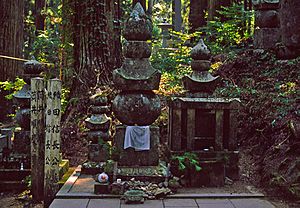
Historical Importance: Unifying Japan
Many powerful lords during the Sengoku period wanted to unite Japan. They hoped to bring back the peace of earlier times. Oda Nobunaga was the first person who seemed able to achieve this goal. He gained control over most of Honshu before his death in 1582. This happened during the Honnō-ji incident, a betrayal by his follower, Akechi Mitsuhide. Nobunaga was betrayed by his own generals. They set the Honno-Ji temple on fire. Nobunaga chose to take his own life rather than be caught in the flames. The reason for Mitsuhide's betrayal was never fully known. It has been a topic of debate ever since.
After the incident, Mitsuhide declared himself the new ruler of Nobunaga's lands. But he was quickly defeated by Toyotomi Hideyoshi. Hideyoshi took control of and greatly expanded the Oda clan's territories. Nobunaga's success in conquering much of Honshu made it easier for his allies, Hideyoshi and Tokugawa Ieyasu, to finish uniting Japan. This goal was finally achieved in 1603. That's when Ieyasu became Shogun after winning the Battle of Sekigahara in 1600.
All three leaders were born within eight years of each other. They started as samurai and ended as important statesmen. Nobunaga took over his father's land at age 17. He quickly gained control of Owari Province. Hideyoshi started in Nobunaga's army as a foot soldier. But he quickly rose through the ranks. Ieyasu first fought against Nobunaga. But he later expanded his own land through a helpful alliance with Nobunaga.
Nobunaga's Impact: Military and Policies
Military Changes
Nobunaga changed how wars were fought in Japan. His gunners, using tanegashima guns, and foot soldiers with long spears became very important. These spears were unusually long, between 18 and 21 feet. Nobunaga designed them himself. These foot soldiers replaced mounted soldiers armed with bows and swords. His foot soldiers were trained for group movements. They wore special uniforms, which helped them feel like a team. He was very strict in battle. He pursued those who fled and killed traitors without mercy. Through his methods, he became the ruler of 20 provinces.
He also built iron-plated warships. He imported saltpeter to make gunpowder. He also encouraged the making of cannons and ammunition.
Economic Policies
After gaining military power in the provinces he controlled, Nobunaga focused on economic growth. He declared "free markets" (rakuichi). He broke trade monopolies and opened up guilds. Nobunaga created rakuichi rakuza policies. These were meant to boost business and the economy. These policies ended monopolies and opened up previously closed groups. He saw these as barriers to trade. These policies greatly helped the economy. Copies of his original announcements can be found in Entoku-ji in Gifu.
Nobunaga also started policies for civil government. These included rules for currency and building roads and bridges. He set standards for road widths and planted trees along roadsides. This made it easier to move soldiers and war materials, as well as goods for trade. Nobunaga always thought about "unifying factors."
Cultural Influence
Nobunaga started a period in Japanese art history called the Azuchi-Momoyama period. He built large gardens and castles. These castles were great works of art themselves. Azuchi Castle had a seven-story main tower. It was filled with gold and valuable objects. Artworks included paintings on screens and sliding doors by Kanō Eitoku. During this time, Nobunaga's tea master, Sen no Rikyū, set up important parts of the Japanese tea ceremony.
Nobunaga was also famous for collecting famous objects. He gathered tea ceremony items with special poetic or historical backgrounds.
Nobunaga was very interested in European culture. This was still new to Japan. He collected Western art, weapons, and armor. He is thought to be one of the first Japanese people to wear European clothes. He also supported Jesuit missionaries in Japan. He helped set up the first Christian church in Kyoto in 1576. However, he never became a Christian himself.
Nobunaga's Family
The Oda clan is believed to be related to either the Fujiwara clan or the Taira clan. Nobunaga's family line can be traced back to his great-great-grandfather.
Immediate Family
Nobunaga was the oldest legitimate son of Oda Nobuhide. His mother was Tsuchida Gozen. She was also the mother of three of his brothers and two of his sisters.
- Father: Oda Nobuhide (1510–1551)
- Mother: Tsuchida Gozen (died 1594)
- Sisters:
- Oichi (1547–1583)
- Oinu
Children
Nobunaga married Nōhime, the daughter of Saitō Dōsan. This was for political reasons. However, she could not have children. His other partners, called concubines, had his children. Kitsuno gave birth to Nobunaga's oldest son, Nobutada. Nobutada's son, Hidenobu, became the leader of the Oda clan after Nobunaga and Nobutada died.
- Sons
- Oda Nobutada (1557–1582)
- Oda Nobukatsu (1558–1630)
- Oda Nobutaka (1558–1583)
- Hashiba Hidekatsu (1567–1585)
- Oda Katsunaga (died 1582)
- Daughters
- Tokuhime (1559–1636)
- Fuyuhime (1561–1641)
Other Important Relatives
One of Nobunaga's younger sisters, Oichi, had three daughters. These three nieces of Nobunaga married important historical figures. Chacha, the oldest, became the partner of Toyotomi Hideyoshi. O-Hatsu married Kyōgoku Takatsugu. The youngest, O-go, married Tokugawa Hidetada. He was the son of Tokugawa Ieyasu and the second shogun.
Images for kids
See also
 In Spanish: Oda Nobunaga para niños
In Spanish: Oda Nobunaga para niños




